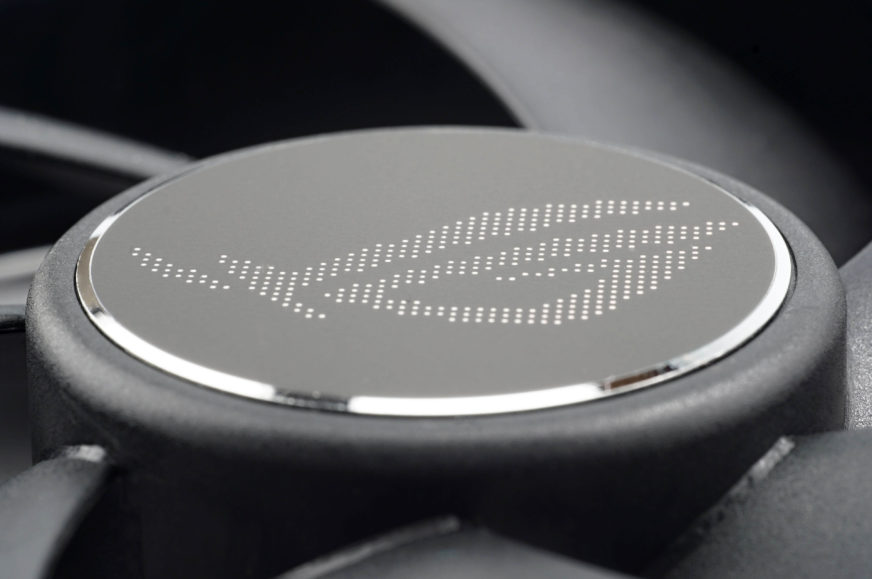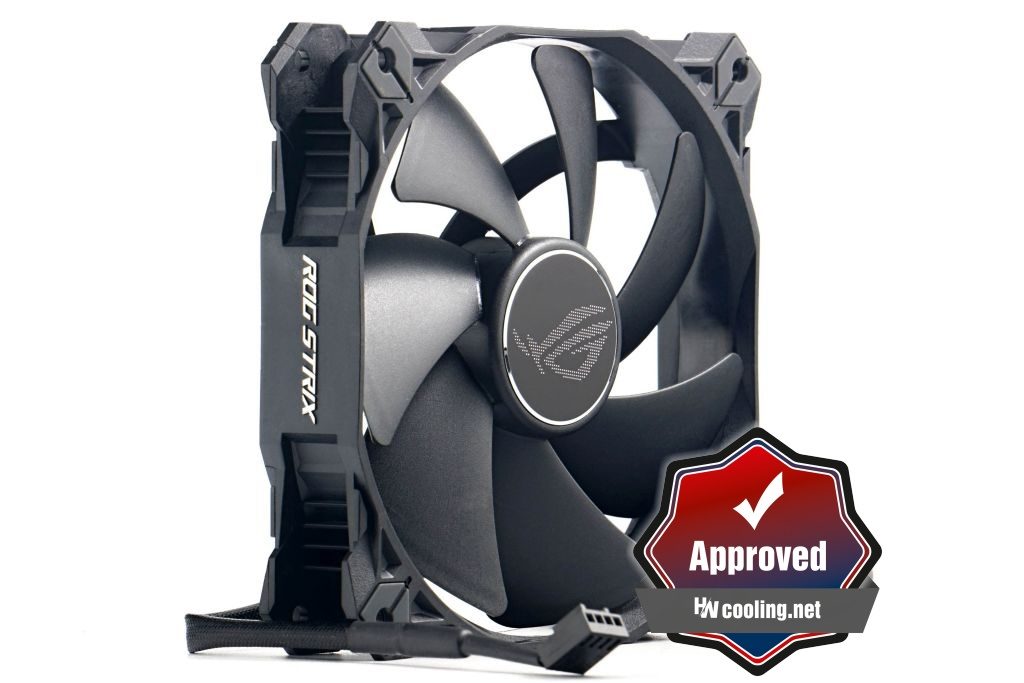Asus ROG Strix XF120 in detail
The first and still the only Asus fan that is on sale individually may be a good choice. But you can also get burnt. It depends on what you want to use it for. In the right context, it gives attractive results, and the impression of a very decent fan is spoiled mainly by pointless design details or sugar-coating the specs. Anyway, you can see that compared to the more ordinary fans from the last test, the Strix is a bit of a different class.
Evaluation
Let’s start with the positive. The Strix XF120’s silent fan bearings are a balm to the ears during operation. Like Noctua fans, they are noiseless. Hand in hand with very low friction goes very low power draw, as the force that the motor is required to overcome is very small. That’s why the start-up speeds are low (from cca 285 rpm), as well as the minimum speed (starts at cca 135 rpm). The only drawback is the short initial rustle, roughly a second, until centering occurs. After that, the running is pretty quiet and some small vibrations get on the frame only at high revs and apparently only due to turbulence.
The airflow is decent, but in this price range it is average to below average in the same noise modes. On the grille, it is outperformed at very low noise by the already more than half-priced Akasa X7 fan. At higher speeds at comparable noise levels, it does have a slight edge over the fans we’ve tested so far, but neither can be considered direct competition – comparisons with it are yet to be made. We already know how the XF120 stacks up against equivalent fans (including the Noctua NF-A12x25), and this verbal assessment is done with that in mind.
For cooling a case, this fan was not properly tuned by its designers and such use is failing, for example, on such trivialities as the collision of the rotor with the dust filter. This is not to say that the XF120 is a bad fan. It will easily justify its operation on cooler radiators. And on top of that, at an impressive price/performance ratio.
However, the static pressure of this fan is above standard, in this it is far ahead cheaper fans across the entire speed spectrum. The only disappontment in this regard are the misleading specifications, which exceed reality (2,29 mm H2O) by 25 %. This is a big difference that does not fall within the stated tolerance. However, when it comes to airflow, Asus specifies the maximum quite precisely.
Among the best fans (and the XF120 ranks among radiator fans within the 120-millimeter range as well), the guideline is which fan is less annoying to listen to.
At slower speeds, the Strix XF120’s sound is characterized by low, or more pleasant, frequencies. And even with use on a radiator. Some more significant hissing occurs only on the plastic dust filter at higher speeds (above 1000 rpm), which is not avoided by other fans. With the XF120, elevated frequencies are in the 4.5-6 kHz band.
If it weren’t for the static pressure misdirection, we might have turned a blind eye and the XF120 would have earned a higher accolade than “Approved”. It’s admittedly more or less a single-purpose fan, but as long as you know exactly what you’re buying it for (and it’s going to be used with respect to what it does best), it doesn’t really matter that much.
English translation and edit by Jozef Dudáš
| Asus ROG Strix XF120 |
| + High static pressure even through restrictive obstacle |
| + Superb results on liquid cooler radiators |
| + Very low speeds possible (stable from approx. 150 rpm) |
| + Virtually noiseless operation of bearings and motor (no non-aerodynamic noises) |
| + Very low power draw below 1 W considering the high performance |
| + Favourable price/performance ratio with regard to static pressure |
| + Expectation of a very long service life |
| - Single-purpose design - Strix XF120 is unsuitable for system cooling |
| - Collides with nylon dust filter |
| - Imperfections in the cosmetics (the surface on some blades is unfinished, with scratches after polishing) |
| Approximate retail price: 23 EUR |
- Contents
- Asus ROG Strix XF120 in detail
- The basis of the methodology, the wind tunnel
- Mounting and vibration measurement
- Initial warm-up and speed recording
- Base 7 equal noise levels…
- .. and sound color (frequency characteristic)
- Static pressure measurement…
- … and airflow
- Everything changes with obstacles
- How we measure power draw and motor power
- Measuring the intensity (and power draw) of lighting
- Results: Speed
- Results: Airflow w/o obstacles
- Results: Airflow through a nylon filter
- Results: Airflow through a plastic filter
- Results: Airflow through a hexagonal grille
- Results: Airflow through a thinner radiator
- Results: Airflow through a thicker radiator
- Results: Static pressure w/o obstacles
- Results: Static pressure through a nylon filter
- Results: Static pressure through a plastic filter
- Results: Static pressure through a hexagonal grille
- Results: Static pressure through a thinner radiator
- Results: Static pressure through a thicker radiator
- Results: Static pressure, efficiency by orientation
- Reality vs. specifications
- Results: Frequency response of sound w/o obstacles
- Results: Frequency response of sound with a dust filter
- Results: Frequency response of sound with a hexagonal grille
- Results: Frequency response of sound with a radiator
- Results: Vibration, in total (3D vector length)
- Results: Vibration, X-axis
- Results: Vibration, Y-axis
- Results: Vibration, Z-axis
- Results: Power draw (and motor power)
- Results: Cooling performance per watt, airflow
- Results: Cooling performance per watt, static pressure
- Airflow per euro
- Static pressure per euro
- Results: Lighting – LED luminance and power draw
- Results: LED to motor power draw ratio
- Evaluation












